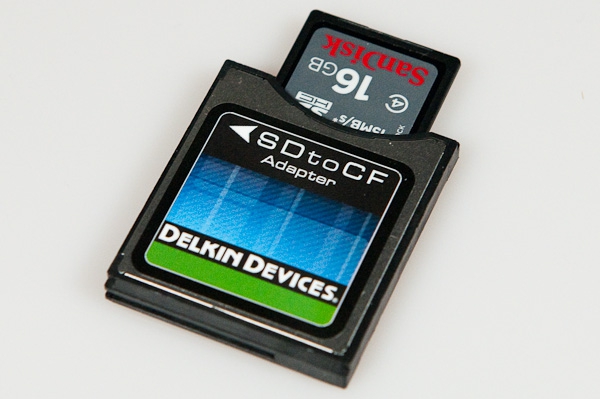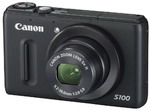Tuesday, December 1, 2009
Delkin's SD to CF Adaptor: It Works Like it Should
Posted by Jason Dunn in "Digital Home Hardware & Accessories" @ 08:00 AM

If you've got a DSLR that's in the prosumer or professional range, odds are that it uses CompactFlash memory cards. While we're starting to see prosumer/professional DSLRs supporting Secure Digital (SD) cards - the D300s has both CF and SD card slots - by and large most of these cameras only support CompactFlash. This leaves laptop users in a quandary: how do you get your images off that CompactFlash card? Sure you, could bring the cable for your camera and move it off that way - but that requires you bring the cable with you, and your camera batteries are draining while that transfer happens. Not ideal. You could bring a USB-based memory card reader with you, but it's one more thing to forget to bring with you. If your laptop has an ExpressCard54 slot, you could use a Delkin ExpressCard CompactFlash Adaptor like I do, but an increasing number of laptops are dropping ExpressCard slots entirely, or going for the narrower ExpressCard34 slots. Delkin has an adaptor for the ExpressCard34 slot, but it sticks out so you can't leave it in all the time. So what do you do? You switch to shooting onto an SD card using the Delkin SD to CF Adaptor that's what. I bought one from Amazon.com [affiliate] for $24.95 USD and wanted to share my experiences using it.
The Delkin SD to CF Adaptor is quite simple: you put an SD or SDHC card into it, and put the adaptor into the CF card slot on your camera. The adaptor is a Type 2 CF card, which is thicker than Type 1, so you'll have to make sure your DSLR supports that size - most CompactFlash memory cards on the market today are Type 1. The adaptor fit easily into my Nikon D300. To go with the adaptor, I picked up a SanDisk Ultra 16 GB SDHC card - this is a Class 4 card that writes at 15 MB/s. I typically only buy Class 6 cards, but I wanted a SanDisk card, and SanDisk only offers the Class 4 Ultra cards (15 MB/s) or the Class 10 Extreme cards (30 MB/s). SanDisk charges double the price for an Extreme card over an Ultra card; they wanted $196 USD for the 16 GB Extreme card at the time of this writing. I wasn't willing to spend double to get 30 MB/s write speeds since my D300 doesn't shoot video, and I wasn't sure if the Delkin adaptor would even allow the faster card to operate at full speed anyway.
When it came time to test, I compared the Delkin SD to CF adaptor with the SanDisk 16 GB Ultra in it to what I normally shoot with: a 8 GB Delkin UDMA Pro CompactFlash card with a write speed of 45 MB/s. See where this is going? I placed my D300 in a stationary position, set the dial to high-speed shooting mode, and held down the shutter released until the camera stopped shooting to see how many frames the camera could shoot with each type of memory card in it. I had a stopwatch and timed how long the write light on my D300 stayed on for - this timed how long it took to write from the camera's buffer to the card. The faster the camera can write to the card and clear its buffer, the faster you can fill the buffer up again. This is a critical factor to anyone who's shooting fast action in burst mode.
How did the numbers go? With both memory cards, I was able to shoot 14 raw images before the camera buffer was full and I had to stop - so there's no difference there. The real difference was in how fast it wrote to each card; it took 45 seconds until the D300 was finished writing to the 16 GB SanDisk Ultra SD card in the Delkin adaptor. By comparison, it only took 17 seconds to write to the 8 GB Delkin UDMA card. The SD card is three times slower than the CF card, so that math makes sense - and it also tells me that the Delkin SD to CF adaptor doesn't impact the write speed of the card very much, if at all. I can't verify that though until I get a faster SD card to test against; I presume that with a Class 10 card writing at 30 MB/s, I'd see my D300 complete writing to the buffer in about 34 seconds. Writing to the card uses battery life, so it's also possible that by tripling the write time, I'll see slightly less battery life on my D300 - but that's for far geekier photographers than I to calculate.
All in all, the Delkin SD to CF adaptor does exactly what it's supposed to do: it allows someone with a CF-based DSLR to use SD cards instead. If you're used to the speeds of a fast CF card though, you're going to be disappointed in the current speeds of SD cards. It depends on the type of shooter you are - if you're shooting sports and routinely fill up the buffer on your DSLR with bursts of shots, the difference between 17 seconds and 45 seconds is vast. There's nothing worse than pressing the shutter release and not being able to take a picture because your camera is busy trying to empty the buffer to the card. On the other hand, if you're a more laid back shooter, rarely firing bursts of shots, you probably won't even notice the extra write time - and you'll appreciate the flexibility of being able to use an SD card that slips easily into your laptop. I tend to be more the latter, so for me, the Delkin adaptor is exactly what I'm looking for - but if I'm heading out to an event where I think I'll need to shoot burst after burst, I may reach for that 8 GB UDMA CF card again...
APRIL 2010 UPDATE: Since publishing this review, I've gotten my hands on both a SanDisk Extreme 16 GB Class 10 SDHC card, and a 16 GB Patriot LX Series Class 10 SDHC card. The results? In both cases, I was able to fire off the same number of raw images before having to stop - 14 images - so from that perspective, there was no improvement in moving to the class 10 cards with this adaptor. The only differences between the two cards was that the SanDisk Extreme card completed writing from the camera buffer in 43 seconds, while the Patriot LX card took 46 seconds - a difference of 7%. Both of those numbers are within spitting range of the 43 seconds the Class 6 SanDisk card, and nowhere near my rosy estimate of 34 seconds for a Class 10 card. Is the adaptor holding back the performance of the Class 10 cards? I'm not so sure - I've done some tests using my Panasonic GF-1 with Class 6 and Class 10 cards, and in every case the Class 10 cards didn't allow me to get off any more frames (seven) than the Class 6 cards. SD cards remain much slower than CF cards, so unless you're never going to fire in burst mode, you might want to stick with fast CF cards.
Jason Dunn owns and operates Thoughts Media Inc., a company dedicated to creating the best in online communities. He enjoys photography, mobile devices, blogging, digital media content creation/editing, and pretty much all technology. He lives in Calgary, Alberta, Canada with his lovely wife, and his sometimes obedient dog. What happened to Flash cards being "dirt cheap"?

Do you enjoy using new hardware, software and accessories, then sharing your experience with others? Then join us on the Thoughts Media Review Team! We're looking for individuals who find it fun to test new gear and give their honest opinions about the experience. It's a volunteer role with some great perks. Interested? Then click here for more information.













